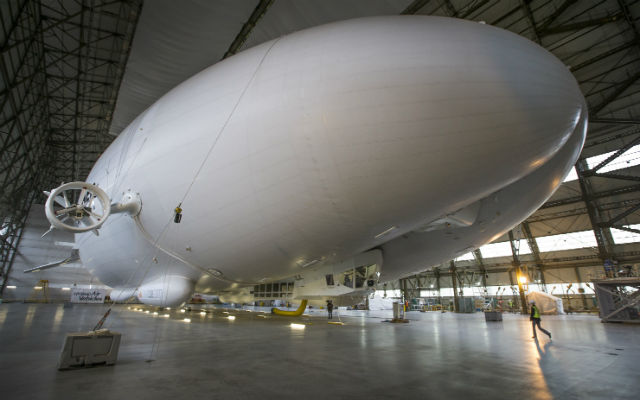The biggest aircraft to grace the skies over Farnborough will make its show debut in July if Hybrid Air Vehicles (HAV) can meet its target of putting its Airlander 10 airship through more than around 20h of flight testing in the next six weeks or so.
UK start-up HAV – which originally developed the 92m (302ft)-long type in partnership with Northrop Grumman for a defunct US Army programme – is repositioning the Airlander 10 as an aircraft suitable for carrying sightseers, surveillance equipment or specialist cargo, and hopes to fly it “within weeks”.
To have it ready for a high-profile flyover during Farnborough show week, Bedford-based HAV will have to complete “phase one” of its test programme – involving six 3h sorties within a 15nm radius of its Cardington base, flying visual flight rules and at a ceiling of 4,000ft – and have moved onto a second more ambitious stage, says Chris Daniels, head of partnerships and communications.
That second stage, requirements of which have also been agreed with the European Aviation Safety Agency, will entail flying up to a total of 80h at a ceiling of 10,000ft and within a radius of 75nm, enough to reach Farnborough. The plan would be to overfly the air show; HAV does not have the infrastructure to land the aircraft other than at its home base.
A Farnborough appearance for the aircraft – which is bigger than an Airbus A380 – would provide a huge marketing coup for the show organisers and the project’s backers, who include rock singer Bruce Dickinson, of Iron Maiden. The company, founded by late aircraft visionary Roger Munk, retained the patent to the Airlander design when the US military programme was cancelled.
“Clearly we want to be there and Farnborough [wants] us to be there,” says Daniels, speaking to Flightglobal at an air show media launch for the show, on 11 May. However, he cautions: “We have to be 100% sure it is safe for us to do so.”

Peter MacDiarmid/REX/Shutterstock
HAV plans around 200h flight testing on its single prototype this year before designing a production version of the aircraft to be ready to deliver in 2018. That iteration is likely to incorporate a repositioned 19-seat passenger cabin, also capable of carrying a 10t payload of cargo or camera equipment, as well as an integrated mooring mast, enabling the Airlander to land without on-ground support. It would also be able to descend onto water.
Thanks to UK and European Union grants – and because the US military funded the bulk of the development before cancelling the long-endurance, multi-endurance vehicle programme in 2013 and returning the prototype to HAV – UK owners have only invested £15m ($22 million) into the programme. With a £25 million price tag, the company needs to sell only two aircraft for them to recoup their investment, says Daniels.
However, the long-term ambition remains a 50t-payload Airlander 50, an aircraft capable of carrying sufficient cargo to make it viable for cargo operators looking to transport equipment to areas inaccessible by road or sea.
The 119m-long airship would have a range of 3,500km and be able to carry six standard shipping containers. “Fifty tonnes is the sweet spot for cargo operators,” says Daniels. “That would open up a whole new market for us.”
Source: Flight International























